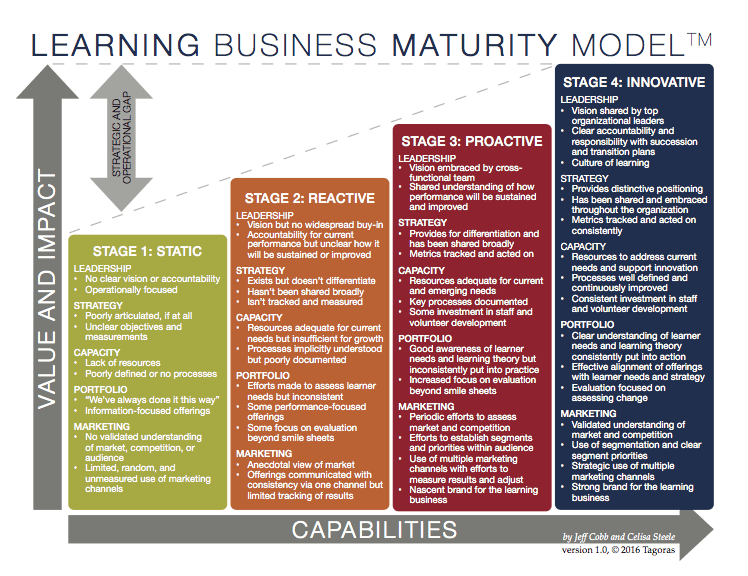You may already be familiar with the Learning Business Maturity Model™, a simple yet powerful tool we created to provide a framework to help organizations assess the maturity of their learning and education businesses. And even though the model has been discussed in a previous episode, we thought it would be helpful to provide some additional clarity on exactly how to use it.
In this episode of the Leading Learning podcast, Celisa and Jeff discuss how to effectively put the Learning Business Maturity Model to work to help you grow and improve your learning business. They offer a refresher of what it is and the three major areas of its application: dialogue, diagnosis, and direction.
To tune in, just click below. To make sure you catch all of the future episodes, be sure to subscribe by RSS or on iTunes. And, if you like the podcast, be sure to give it a tweet!
Listen to the Show
Read the Show Notes
[00:18] – A preview of what will be covered in this podcast where Celisa and Jeff discuss the Learning Business Maturity Model and how leaders can use it to grow their businesses.
[00:36] – Below is a message from NextThought, our sponsor for the third quarter of 2018.
Brought to you by NextThought, AssociationsNext.com is your opportunity to learn from some leading thinkers in eLearning and membership organizations, as well as giving you the chance to test drive the NextThought LMS platform. In this educational series, you’ll uncover new knowledge about instructional design, digital strategy, and staying true to your organization’s long-term goals in the face of rapid change. KiKi L’Italien, Tracy King, and Lowell Aplebaum lead the first three modules, and more courses will be added on a monthly basis. Visit AssociationsNext.com to enroll and experience the revolutionary NextThought LMS for yourself.
[01:25] – A discussion about how the topic for this episode stemmed from a comment of a Learning • Technology • Design™ participant who said they weren’t as clear what to do with the Learning Business Maturity Model as they were with the Value Ramp™.
What is the Learning Business Maturity Model?
[02:50] – A brief overview of what the Learning Business Maturity Model is for those who may not be familiar with it or who simply need a little refresher.
We first introduced the model at our Leading Learning Symposium a couple of years ago, and our aim with it was to articulate the characteristics and practices of a mature learning and education business or line of business, as well as the stages that typically precede full maturity.
It is intended specifically for market-facing organizations or units within organizations that focus on lifelong learning, continuing education, and professional development. It is not intended for corporate training departments or degree-granting programs, for example.
There are basically two key aspects of the model.
The first is that the model spans four stages of maturity:
- Stage 1: Static
- Stage 2: Reactive
- Stage 3: Proactive
- Stage 4: Innovative
Make sure to check our previous episode on the Learning Business Maturity Model.
The other key aspect of the model is that maturity in each stage is gauged according to characteristics and performance in five domains we have found to be critical to the success of the learning and education businesses we’ve been involved with over the years.
You might be wondering exactly how you “gauge” your business in these domains, and the answer is that we have also created an assessment (free) you can take to score yourself. Just use the button below to request it.
The five domains include:
- Leadership– How clear is the vision for the learning and education business? How is accountability for achieving the vision shared and sustained over time? Is there a culture of learning throughout the organization and its audience?
- Strategy– How clearly articulated is the strategy? Has it been communicated and embraced broadly throughout the organization? Are clear metrics established and tracked, and does the organization adjust strategy based on the data captured?
- Capacity– Does the organization have sufficient capacity, in terms of human resources and technology, to pursue the vision and strategy effectively?
- Portfolio– Are the content, methodologies, and modalities aligned with well researched, thoroughly understood learner needs? Is the impact of learning assessed at multiple levels over time?
- Marketing– Is there a validated understanding of the overall market and competitive environment? Are appropriate marketing methodologies used consistently and tracked for effectiveness?
How to Use It
[06:51] – Now to the topic of how to use the model. We’ll break it down into three major areas: dialogue, diagnosis, and direction.
Dialogue
Like the Value Ramp (see our previous episode, 8 Tips for Optimizing Your Value Ramp to learn more), the Learning Business Maturity Model can be extremely valuable as a conversation starter.
This is true whether or not you take the assessment—just putting it up on the screen during a staff or board meeting will almost certainly spark useful commentary and insights.
From our own exchanges, we’ve found a good probing question/discussion starter to get some of can just be, which of the five domains are we strongest in? And, similarly, which are we weakest in?
We’ve found the Learning Business Maturity Model can be particularly helpful in board conversations because it helps board members tune into the fact that learning is a business and needs to be viewed and managed as one.
If you have taken the assessment, then you should have the basis for an even more focused discussion. In fact, if you do plan to conduct the assessment, we recommend that you not have much, if any, discussion about the model in advance as you don’t want individual perspectives to be overly influenced by the group.
Diagnosis
[11:58] – The reason for having dialogue, of course, is that it is a valuable component of diagnosing your situation.
We have said many times before that a solid diagnosis is really at the heart of good strategy. It’s also at the heart of identifying the operational issues that may be standing in the way of successfully growing and developing your learning business.
As you engage in the kind of dialogue the maturity model prompts, you are almost always going to hear a range of ideas and hypotheses that relate to your strategy and to your operations—theories about what you should or shouldn’t be doing and about what you are good at or not so good at.
The key is to maintain perspective and recognize that these usually are just theories.
Make sure you have someone taking notes. You will want to capture everything that is said and start looking for patterns.
What are the comments and ideas that pop up most frequently?
These are clues to where you need to dig deeper, whether that means reaching out to members and customers to gather more data, doing competitive research, or taking a more detailed look at some of your current processes and procedures to understand where there are gaps.
The Learning Business Maturity Model provides a framework that makes it much more likely you will unearth the areas where you need to go deeper. It helps you to focus what could easily be a scattershot, hit-or-miss approach to better understanding your business.
Direction
[14:04] – And, of course, the reason you need that focus and solid diagnosis is that you ultimately need a clear sense of direction for your learning business, and that’s the third and final area we want to cover.
By engaging with the model, you ultimately want to arrive at the clear actions you will take. These generally fall into three areas:
- Strategy: what’s going on, how will you position yourself in the market
- Hiring and succession: this is a sort of competency model
- General performance: what are the processes and practices that need to be institutionalized; where do bad ones need to be abandoned, new ones need to be developed?
Remember it starts with the first “D”, dialogue – not monologue – and that involves back and forth.
And the third “D”, direction, really what you get out of using a tool like the Learning Business Maturity Model is that you have a shared basis, language, and areas to focus on—and that’s very powerful because it puts everybody on the same page. It’s also a good example of a social learning object.
[19:29] – Wrap Up
If you are getting value from the Leading Learning podcast, be sure to subscribe by RSS or on iTunes. We’d also appreciate if you give us a rating on iTunes by going to https://www.leadinglearning.com/itunes.
And we would be grateful if you would visit AssociationsNext.com. We put a lot of effort in to the Leading Learning Podcast, and one of the main reasons we’re able to do that is because of the support of sponsors. So, please visit AssociationsNext.com, where you’ll have the chance to learn and to experience the NextThought LMS in action.
Also, consider telling others about the podcast. Go to https://www.leadinglearning.com/share to share information about the podcast via Twitter, or send out a message on another channel of your choosing with a link to https://www.leadinglearning.com/podcast.
[25:56] – Sign off
See also:





Leave a Reply